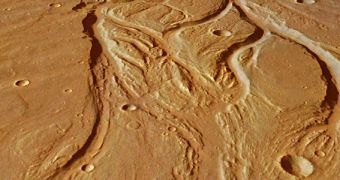Astronomers with the European Space Agency (ESA) say that their Mars Express orbiter was recently able to identify a series of narrow gorges and islands in the Valles Marineris canyon system, which appear to have been created through erosion by the fast-moving waters of an ancient river. No signs of the river remain today, as it most likely dried out millions to billions of years ago.
The landscape features in the image above are located on the southeastern margin of the system, which is one of the largest canyons in the solar system. In length, it is exceeded only by Baltis Vallis on Venus, and in depth just by Earth's rift valleys, at the bottom of the ocean. It is 4,000 kilometers (2,500 miles) in length, about 200 kilometers (120 miles) across, and 7 kilometers (4.3 miles) deep.
The photo ESA has just released is focused on the central portion of Osuga Valles, which is an integral portion of the overall system. Mars Express captured an image of this landscape feature on December 7, 2013. The probe conducted an investigation in this area in order to analyze the extremely chaotic and eroded terrain that permeates the eastern section of Valles Marineris.
“Catastrophic flooding is thought to have created the heavily eroded Osuga Valles and the features within it. Streamlines around the islands in the valley indicate that the direction of flow was towards the northeast […] and sets of parallel, narrow grooves on the floor of the channel suggest that the water was fast flowing,” experts at ESA announce in a press release dated April 10.

 14 DAY TRIAL //
14 DAY TRIAL //